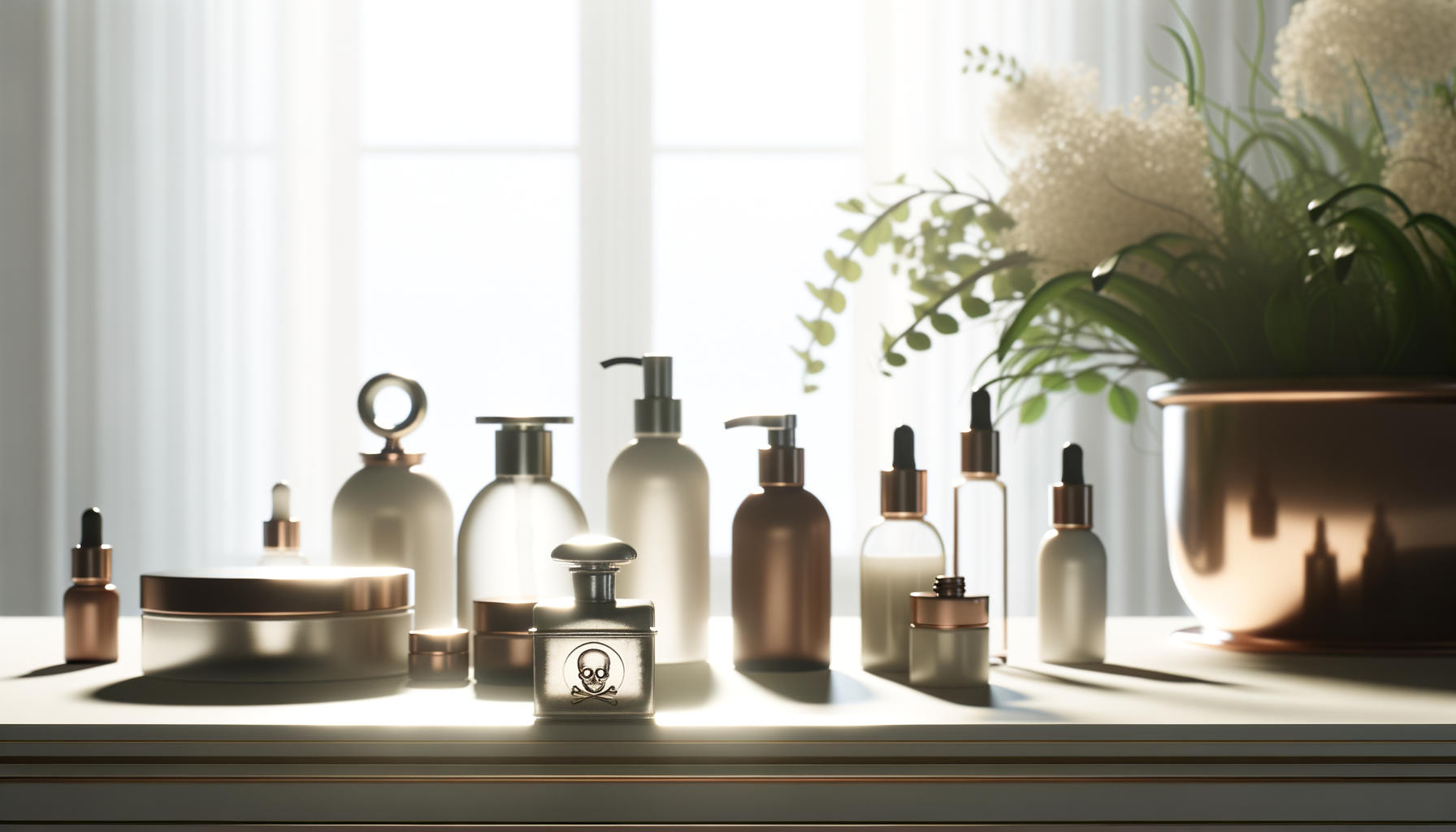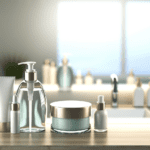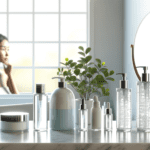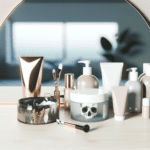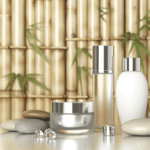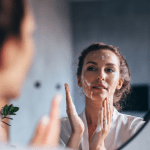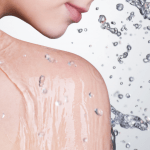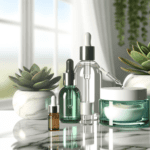Introduction to Arsenic in Skincare
The prevalence of arsenic in the environment
Arsenic, a naturally occurring element found in the Earth’s crust, pervades our environment, infiltrating the water, air, and soil that sustain life. Its ubiquity is such that traces of arsenic can be detected in many of the natural resources we consume daily. While arsenic has industrial applications, its presence in the environment raises concerns when it comes to personal care products, particularly skincare, where the potential for direct and prolonged exposure is significant.
How arsenic can infiltrate skincare products
The journey of arsenic into skincare products is often a tale of unintended consequences. It can be introduced through contaminated water used in manufacturing, or it may be present in natural ingredients sourced from arsenic-rich soils. Additionally, certain mineral-based additives, prized for their beneficial properties, may also harbor this toxic element. The lack of stringent regulations and oversight in some regions further exacerbates the risk of arsenic contamination in skincare items.
This is not a problem of water-free skincare products as they don’t contain water. Water-free skincare products can actually be made without any chemicals and definitely deserve to be tried out if you have not yet.
Potential health risks associated with arsenic exposure
Exposure to arsenic, even in small quantities, is not without peril. It has been linked to a myriad of health issues, ranging from skin irritation and allergic reactions to more severe consequences such as skin cancer and systemic toxicity. The risk is compounded by the fact that skincare products are designed for regular use, potentially leading to cumulative exposure over time.
Overview of the article’s purpose and importance
This article aims to shed light on the alarming reality of arsenic in skincare products, a topic that has flown under the radar for far too long. By examining the pathways through which arsenic enters these products, the potential health risks it poses, and the current regulatory landscape, we seek to inform and empower consumers. Understanding the implications of arsenic in skincare is crucial for making informed choices and advocating for safer products in an industry where beauty should never come at the cost of health.

Do you have the most commonly used but toxic, disease bringing chemicals in your skin care? Many chemicals in skincare are hormone disruptors and make menopause symptoms worse.
Find out more…
Understanding Arsenic
What is arsenic and its common forms
Arsenic is a naturally occurring element found in the Earth’s crust, recognizable by its symbol ‘As’ and atomic number 33. It exists in various chemical forms, which are categorized into two broad groups: inorganic and organic arsenic compounds. Inorganic arsenic, found in soils, groundwater, and minerals, is typically more toxic and can be present as compounds such as arsenite (AsIII) and arsenate (AsV). Organic arsenic compounds, which include arsenobetaine and arsenocholine, are generally found in fish and shellfish and are less harmful to health.
Natural vs. synthetic sources of arsenic
Arsenic is released into the environment both through natural processes and human activities. Natural sources include volcanic eruptions and the erosion of arsenic-containing minerals. Synthetic sources, on the other hand, arise from industrial processes such as mining, smelting, and the burning of fossil fuels. Arsenic has also been used historically in pesticides, herbicides, and insecticides, contributing to its presence in agricultural soils.
Arsenic’s role in industry and consumer products
Despite its toxicity, arsenic has been utilized in a variety of industrial applications. Historically, it was a component of lead alloys for car batteries, and it has been used in the production of glass and semiconductors. In consumer products, arsenic compounds have been employed as wood preservatives and in certain types of animal feed. Alarmingly, arsenic has also been found in some skincare products, where it may be present due to contaminated ingredients or as a byproduct of manufacturing processes.
Regulations and safety levels for arsenic
Recognizing the potential health risks posed by arsenic, regulatory agencies worldwide have established safety levels for arsenic in drinking water, food, and consumer products. The World Health Organization (WHO) recommends a maximum arsenic concentration of 10 micrograms per liter in drinking water. In the United States, the Environmental Protection Agency (EPA) enforces this standard, while the Food and Drug Administration (FDA) regulates arsenic levels in food and cosmetics. However, the challenge of enforcing these regulations globally is compounded by varying standards and the complexity of monitoring and controlling arsenic contamination.
It is essential for consumers to be aware of the presence of arsenic in products and to advocate for stringent regulations and transparent labeling to minimize exposure and associated health risks.
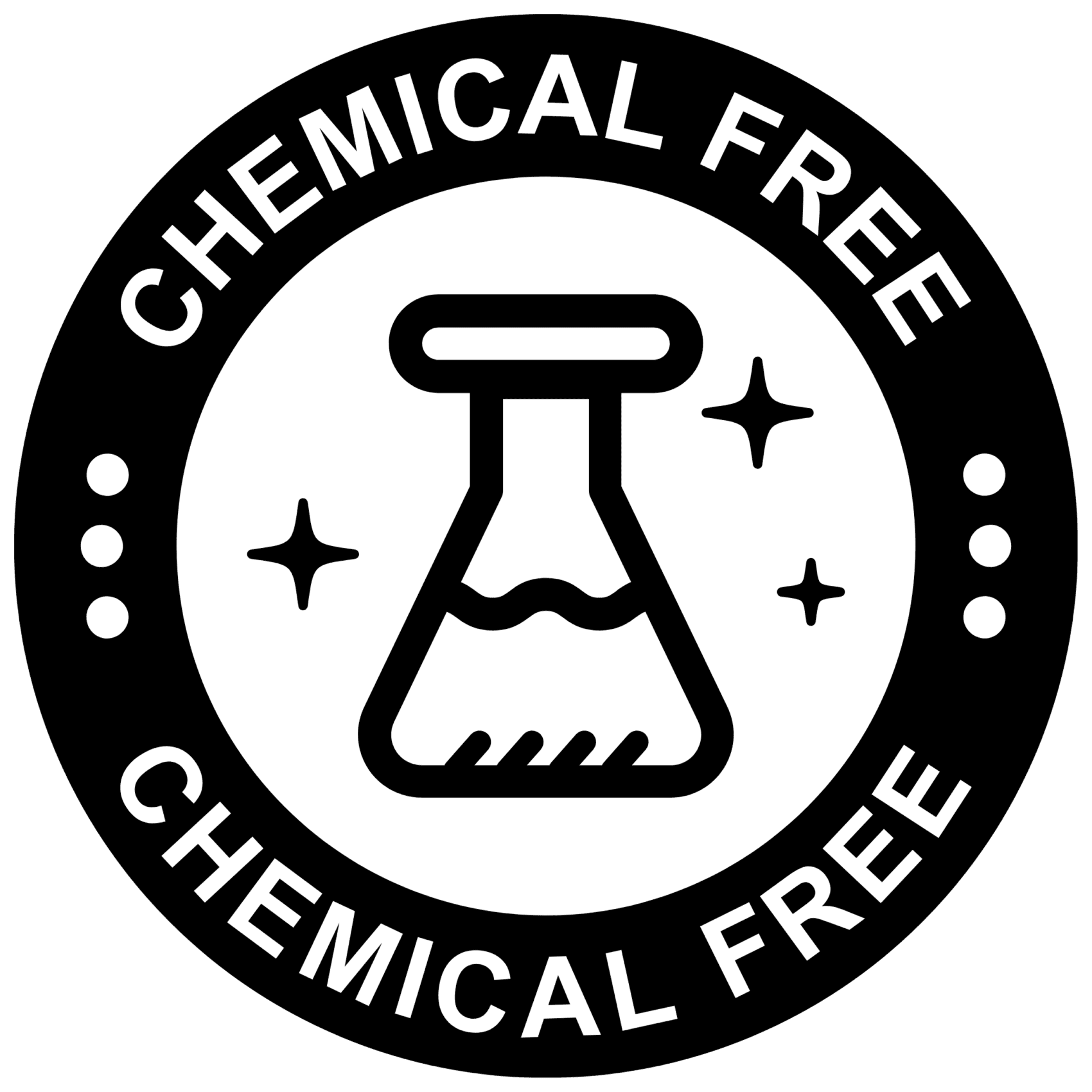
Doubting chemicals in skincare and femcare? Well done! Choose chemical-free products whenever possible.
Arsenic in Skincare: The Hidden Danger
Common skincare products that may contain arsenic
Unbeknownst to many consumers, arsenic, a naturally occurring element that can be toxic in certain forms, has been detected in a variety of skincare products. These include facial creams, lotions, sunscreens, and even whitening toothpastes. The presence of arsenic is not always due to direct addition; it often enters the product as a contaminant from raw materials or during the manufacturing process.
The process of arsenic contamination in skincare production
Arsenic contamination can occur at several points during the production of skincare products. It can be introduced through contaminated water used in manufacturing, or it may be present in mineral-based ingredients, such as talc or mica, which are commonly used as fillers or to provide shimmer in cosmetics. Additionally, arsenic can be a byproduct of chemical reactions involving other substances within the product formulation.
Identifying arsenic on product labels
Identifying arsenic in skincare products is challenging for consumers because it is not listed explicitly on ingredient labels. Arsenic is not an intentionally added ingredient but rather a contaminant, so it falls under the radar of labeling requirements. Consumers looking to avoid arsenic should be cautious of products sourced from areas with high arsenic levels in the soil or water and opt for brands that rigorously test for heavy metal contaminants.
The impact of arsenic on skin health
The impact of arsenic on skin health can be significant. Short-term exposure to arsenic can cause skin irritation, discoloration, and rashes. Long-term exposure, even to low levels, increases the risk of skin cancer and can lead to chronic skin conditions. Arsenic can also interfere with the skin’s natural barrier function, making it more susceptible to other environmental toxins.
It is imperative for consumers to be aware of the potential for arsenic contamination in skincare products and to take proactive steps to protect their health. Choosing products from reputable companies that test for heavy metals, reading ingredient lists carefully, and staying informed about the sources of cosmetic ingredients can help mitigate the risks associated with arsenic exposure.

Popular Read: Endocrine Disruptors in Skincare: What You Need to Know
Health Implications of Arsenic Exposure
Short-term and Long-term Health Effects
The health implications of arsenic exposure can be both immediate and insidious, manifesting over time. Short-term exposure to high levels of arsenic can lead to acute symptoms such as nausea, vomiting, abdominal pain, and diarrhea. In severe cases, it can result in muscle cramping, cardiac arrhythmias, and even death. Long-term exposure, even at lower levels, is particularly concerning. Chronic arsenic ingestion has been linked to an increased risk of cardiovascular disease, including coronary artery disease, stroke, and peripheral artery disease. It can also lead to skin lesions, developmental effects, neurotoxicity, and diabetes. Furthermore, arsenic is a known carcinogen, with long-term exposure associated with an increased risk of lung, bladder, and skin cancers.
Specific Risks for Women’s Health and Hormonal Balance
Women may face unique health challenges when it comes to arsenic exposure. The presence of arsenic in skincare products is particularly alarming given the potential for direct skin contact and systemic absorption. Studies suggest that arsenic can disrupt endocrine function, leading to hormonal imbalances. This disruption can have a range of effects on women’s health, including impacts on fertility, menstrual cycles, and menopause. Additionally, pregnant women exposed to arsenic may experience complications such as preterm birth or give birth to infants with low birth weight.
The Link Between Arsenic and Aging Concerns
Arsenic exposure has also been implicated in the acceleration of the aging process. It can induce oxidative stress, which damages cells and tissues, contributing to the appearance of premature aging. Skin exposed to arsenic may show signs of aging such as wrinkles, pigmentation changes, and a loss of elasticity. Moreover, arsenic’s role in the development of chronic diseases can further exacerbate age-related health concerns, compounding the overall impact on an individual’s well-being.
Case Studies and Research Findings
Research findings provide a stark illustration of the dangers posed by arsenic. A 2018 review published in the British Medical Journal assessed studies from over a dozen countries and found that higher urine levels of arsenic were associated with a 15%-85% higher risk for stroke and heart disease. In China, a study linked elevated blood levels of arsenic with carotid plaque in individuals with Type 2 diabetes. In Spain, increased rates of newly diagnosed cardiovascular disease were associated with cadmium in urine, a metal often found in conjunction with arsenic. These case studies underscore the global nature of arsenic exposure and its significant health implications.
Given the insidious nature of arsenic and its ability to accumulate in the body over time, the health risks it poses cannot be overstated. It is crucial for consumers to be aware of the potential for arsenic contamination in skincare products and to take proactive measures to minimize their exposure. As research continues to reveal the extensive health implications of arsenic, it becomes increasingly clear that regulatory measures and consumer education are essential for safeguarding public health.
Do you know the three main ways that your body gets in touch with harmful chemicals with everyday products? Knowledge is Power!
The Ultimate Detox Guide will tell you how to lower your exposure to harmful chemicals!

Navigating the Market: Making Informed Choices
How to Read and Understand Ingredient Lists
Understanding the ingredients in skincare products is crucial for making informed choices. Ingredient lists can be daunting, but they are organized in descending order of concentration. The first five ingredients typically make up the majority of the product. Watch for names like ‘parfum’ or ‘fragrance,’ which can hide a multitude of chemicals. Familiarize yourself with common harmful ingredients, such as parabens, sulfates, and phthalates. Look for their scientific and alternative names, as they can be listed under different terms. Remember, the smaller the font, the more crucial it is to scrutinize.
Tips for Selecting Safer Skincare Products
- Research Brands: Choose brands with a transparent approach to ingredients and sourcing.
- Check Certifications: Look for certifications like USDA Organic, Non-GMO Project Verified, or EWG Verified, which indicate safer product standards.
- Patch Test: Always perform a patch test with new products to check for skin reactions.
- Less is More: Products with fewer ingredients reduce the risk of exposure to harmful substances.
The Role of Certifications and What They Mean
Certifications can be a helpful guide in selecting safer skincare products. However, it’s important to understand what each certification means. For instance, USDA Organic ensures that ingredients are free from pesticides and synthetic additives. EWG Verified means a product meets the Environmental Working Group’s strict health criteria. While certifications are a good starting point, they are not foolproof. Some certifications have more rigorous standards than others, and some harmful ingredients may still slip through. Always combine certifications with your own research.
How to Pick Safe Skincare
If you want to stay on the safe side, opt for water-free products because they can be made without chemicals, which are detrimental to your health.
Because water is a breeding ground for bacteria, mold and microbes, which means that water-based lotions, creams, balms etc. contain chemical preservatives like alcohol, parabens, and other chemicals. These are not only deadly to the microbes but also harmful for humans; many act as endocrine disruptors (hence they are called endocrine-disrupting chemicals, EDC, which means they disturb your hormone system, which, after all, contributes even more to dry and / or sagging skin. Look for products that don’t list water (aqua, eau, juice) in the ingredient list because when a product lists these, it will contain preservatives (chemicals).
The water-free skincare line of Damiva is a line of patented chemical-free, water-free products that are long-term safe.
Resources for Researching Product Safety
There are several resources available for researching product safety. The Environmental Working Group (EWG) provides a database of products with safety ratings. Apps like Think Dirty and EWG’s Healthy Living allow you to scan product barcodes for immediate information on ingredients. Websites such as Cosmetics Info and Safe Cosmetics offer detailed information on ingredients and regulations. Utilize these tools to stay informed and make choices that align with your health and safety values.
By educating yourself on how to read ingredient lists, understanding certifications, and utilizing available resources, you can navigate the skincare market with confidence. Remember, your skin is your largest organ, and what you apply to it can impact your overall health. Choose wisely, and don’t hesitate to reach out to brands for more information. Your health is worth the extra effort.
Holistic and Natural Alternatives
Natural Ingredients and Their Benefits for Skin Health
Turning to nature offers a treasure trove of benefits for skin health. Natural ingredients such as aloe vera, tea tree oil, and shea butter are renowned for their healing properties. Aloe vera, for instance, is a potent moisturizer and anti-inflammatory agent, making it ideal for soothing sunburns and reducing skin irritation. Tea tree oil is celebrated for its antibacterial and antiseptic qualities, which can help in treating acne and other skin infections. Shea butter is rich in vitamins and fatty acids, which help to nourish and protect the skin, maintaining its elasticity and preventing dryness.
DIY Skincare Recipes and Their Advantages
Creating your own skincare products at home can be both rewarding and beneficial. DIY recipes allow you to control the ingredients, avoiding harmful chemicals and tailoring the product to your specific skin needs. For example, a simple face mask made from honey and cinnamon can offer anti-inflammatory and antibacterial benefits, while an oatmeal and yogurt mask can gently exfoliate and moisturize the skin. The advantages of DIY skincare include cost-effectiveness, the joy of customization, and the peace of mind that comes from using pure, natural ingredients.
The Importance of a Holistic Approach to Skincare and Health
A holistic approach to skincare considers the entire well-being of an individual, recognizing that skin health is influenced by various factors including diet, stress levels, and environmental exposure. Embracing a holistic view encourages the use of skincare products that not only benefit the skin’s surface but also support the body’s overall health. This approach often involves using products with fewer, but higher quality, natural ingredients and integrating practices such as proper nutrition, hydration, and stress management into daily routines.
Lifestyle Changes to Support a Toxin-Free Regimen
To fully embrace a toxin-free lifestyle, consider making several key lifestyle changes. Start by scrutinizing product labels and opting for items with recognizable, natural ingredients. Incorporate organic foods into your diet to reduce the intake of pesticides and chemicals. Prioritize self-care practices such as adequate sleep, regular exercise, and mindfulness to reduce stress, which can have a direct impact on skin health. Additionally, consider reducing the use of synthetic fragrances and opting for natural alternatives like essential oils. By making these changes, you can support a healthier, more radiant complexion and overall well-being.
Conclusion: Empowerment Through Education
Summarizing the Key Takeaways
The presence of arsenic in skincare products is a concerning reality that poses significant health risks. Throughout this article, we’ve explored how arsenic enters the environment and, subsequently, our skincare items. We’ve learned about the potential health risks associated with arsenic exposure, including skin damage, hormonal imbalances, and links to certain cancers. Understanding the common forms of arsenic, its natural and synthetic sources, and the regulations surrounding its use in consumer products has equipped us with the knowledge to make informed decisions about our skincare routines.
Encouraging Proactive Health and Beauty Practices
Empowerment begins with taking proactive steps towards a healthier lifestyle. This includes reading and understanding ingredient lists on skincare products, selecting safer alternatives, and advocating for stricter regulations on harmful substances. By choosing products that are transparent about their ingredients and opting for those with certifications that guarantee safety, we can protect our skin and overall health.
Final Thoughts on Maintaining a Chemical-Free Lifestyle
Maintaining a chemical-free lifestyle extends beyond skincare. It encompasses all aspects of our daily lives, from the food we eat to the household products we use. By adopting a holistic approach to health, which includes natural skincare alternatives and lifestyle changes, we can minimize our exposure to toxins like arsenic. Embracing DIY skincare recipes, understanding the benefits of natural ingredients, and making conscious choices can lead to a healthier, more sustainable way of living.
Invitation to Continue the Conversation and Self-Education
The journey towards a toxin-free lifestyle is ongoing and requires continuous education and awareness. We invite you to keep the conversation going by engaging with communities that share this mission, participating in forums, and staying updated on the latest research. Self-education empowers us to make choices that not only benefit our health but also contribute to a safer environment for future generations.
